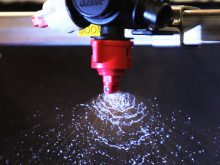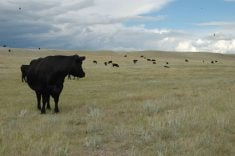STONY PLAIN, Alta. – Laying hens of the future will continue to live in cages, says a provincial livestock specialist, but their cages will be modified with separate nesting boxes and roosts.
“I think this is the future,” said John Church during an egg farm field day.
During his doctoral thesis, Church put a clothesline in front of the laying cages and hung a toy from the line for the chickens to peck at.
This simple modification increased egg production six percent and decreased mortality. It also increased feather count, which is an indication of stress.
Read Also

Soybean market still figuring out implications of China-U.S. pact
Soybean futures had a muted reaction to the U.S. trade deal with China as the market tries to figure out the nuances of the deal.
“This told me there was room to make modifications to existing equipment,” he said.
Work has already been done to “enrich” laying hen cages by adding separate nesting areas and perches for the hens to roost at night.
Charlie Van Arnam, a director on the Alberta Egg Producers Board, said it wouldn’t be long before North America follows the European lead to modified cages.
“You will see more and more of these enriched cages.”
Manfred Kanehl, of Holborn Poultry Farms where the tour took place, imports modified cages from Germany and distributes them in North America.
His company has installed modified cages in three commercial breeding barns in Manitoba, Ontario and British Columbia.
He said the new cages will be the norm in Canada in 20 years.
Chickens will lay eggs in the new cages’ nesting areas 95 percent of the time and roost on the perch at night, he said.
It’s not cheap to convert. The new cages cost $14 a bird compared to $10 a bird for traditional cages. Switching his 100,000-hen farm to new cages cost $1.5 million.
Except for a few farms selling to niche markets, Kanehl doesn’t think the laying industry will revert to free-range chickens.
“If we put the eggs back on the floor we go back where we were 50 years ago.”
He said disease increases significantly when eggs are on the ground with the chicken’s manure. Manure left on eggs for five days penetrates the shell and contaminates the inside.
“The biggest plus in cages is we don’t have to feed antibiotics,” he said on a tour of the barns.
The tour was organized by the Alberta Egg Producers Board, Alberta Farm Animal Care and Alberta Agriculture. It was designed to let people know egg producers treat their hens humanely.
Kanehl said it would be impossible to move modern chickens out of their cages into larger, more open areas.
The high-strung birds have been bred for more egg production. Chickens laid 19 dozen eggs a year when Kanehl started in 1962. Now it’s normal for chickens to lay 24 dozen eggs a year.
“We have a different chicken than we had 50 years ago. It’s not the same chicken our grandmother had.”
He thinks the industry should be satisfied with the egg production. Researchers should now focus on the chicken’s disposition.
“I say let’s be satisfied with the eggs and get the breed calmer.”














